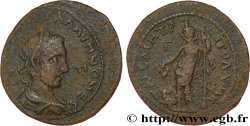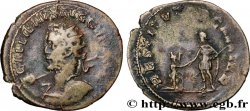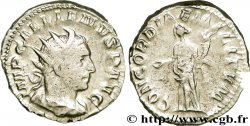v16_0626 - GALLIENUS Antoninien
MONNAIES 16 (2002)
Starting price : 100.00 €
Estimate : 200.00 €
Realised price : 100.00 €
Number of bids : 1
Maximum bid : 110.00 €
Starting price : 100.00 €
Estimate : 200.00 €
Realised price : 100.00 €
Number of bids : 1
Maximum bid : 110.00 €
Type : Antoninien
Date: 257-258
Mint name / Town : Trèves
Metal : billon
Millesimal fineness : + 250 ‰
Diameter : 21,5 mm
Orientation dies : 12 h.
Weight : 4,70 g.
Rarity : R1
Officine: 1re
Emission: 2e
Coments on the condition:
Très beau portrait pour un type très intéressant. Flan large et complet. Frappe un peu faible au revers. Jolie patine de médaillier
Predigree :
Cet exemplaire provient de MONNAIES VII, 26 juillet 1999, n° 223 et de MONNAIES XIII, 30 juillet 2001, n° 689
Obverse
Obverse legend : IMP GALLIENVS. P. AVG.
Obverse description : Buste radié et cuirassé de Gallien à droite, vu de trois quarts en avant (B).
Obverse translation : Imperator Gallienus Pius Augustus”, (L’empereur Gallien Pieux auguste).
Reverse
Reverse legend : IOVI V-ICTORI.
Reverse description : Jupiter nu debout à gauche sur un cippe, tenant une victoriola de la main droite et un sceptre long de la gauche ; sur le cippe est inscrit en deux lignes : IMP/ C E S.
Reverse translation : “Iovi Victori”, (À Jupiter victorieux).
Commentary
Poids lourd.
Heavy weight
Heavy weight








 Report a mistake
Report a mistake Print the page
Print the page Share my selection
Share my selection Ask a question
Ask a question Consign / sell
Consign / sell
 Full data
Full data









